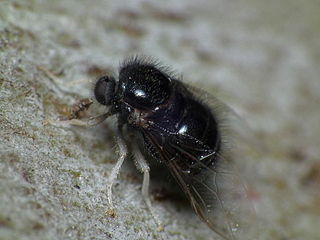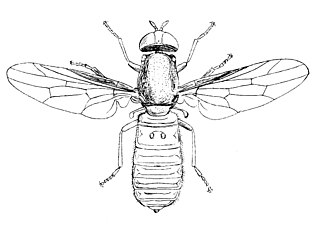
The Bombyliidae are a family of flies. Their common name are bee flies or humbleflies. Adults generally feed on nectar and pollen, some being important pollinators. Larvae generally are parasitoids of other insects.

The Acroceridae are a small family of odd-looking flies. They have a hump-backed appearance with a strikingly small head, generally with a long proboscis for accessing nectar. They are rare and not widely known. The most frequently applied common names are small-headed flies or hunch-back flies. Many are bee or wasp mimics. Because they are parasitoids of spiders, they also are sometimes known as spider flies.

Phyllophaga is a very large genus of New World scarab beetles in the subfamily Melolonthinae. Common names for this genus and many other related genera in the subfamily Melolonthinae are May beetles, June bugs, and June beetles. They range in size from 12 to 35 mm and are blackish or reddish-brown in colour, without prominent markings, and often rather hairy ventrally. These beetles are nocturnal, coming to lights in great numbers.

The Scenopinidae or window flies are a small family of flies (Diptera), distributed worldwide. In buildings, they are often taken at windows, hence the common name window flies.

Bombylius major is a parasitic bee mimic fly. B. major is the most common type of fly within the Bombylius genus. The fly derives its name from its close resemblance to bumblebees and are often mistaken for them.
Heterostylum is a genus of flies belonging to the family Bombyliidae (bee-flies). There are 14 described species, distributed throughout the Americas. These are robust and very hairy flies with a body length of 10–15 mm. They can be distinguished from similar genera by an indentation in the hind margin of the eye and unique wing venation.

Toxophora is a genus of flies belonging to the family Bombyliidae (bee-flies). There are 47 described species, distributed throughout the world, although they are most abundant in Southwestern United States and western Mediterranean. World catalog of bee flies They are strange, stout, robust flies with a hunchbacked form, with a body length of 6–12 mm and wings 4 to 7.5mm. Most species are black with banding or spots.

Dipalta is a genus of flies belonging to the family Bombyliidae (bee-flies). The genus is closely related to Villa.

Exoprosopa jacchus is a species of 'bee flies' belonging to the family Bombyliidae subfamily Anthracinae.

Brachyanax is a genus of bee fly in the subfamily Anthracinae. It was circumscribed by Neal Evenhuis in 1981. Thirteen species are recognized, and they are found in Asia and Australasia.
Exoprosopa parda is a species of bee flies in the family Bombyliidae.
Exoprosopa pueblensis is a species of bee flies in the family Bombyliidae.

Exoprosopa iota is a species of bee flies in the family Bombyliidae.
Exoprosopa rostrifera is a species of bee flies in the family Bombyliidae.
Exoprosopa doris is a species of bee flies in the family Bombyliidae.
Exoprosopa meigenii is a species of bee flies in the family Bombyliidae.

Exoprosopa fasciata is a species of bee flies in the family Bombyliidae.

Exoprosopa decora is a species of bee flies in the family Bombyliidae.
Exoprosopa eremita is a species of bee flies in the family Bombyliidae.
Heterotropus is a genus of bee flies in the family Bombyliidae. It is the only genus in the subfamily Heterotropinae, which formerly contained at least four genera. There are more than 45 species in the genus Heterotropus.












